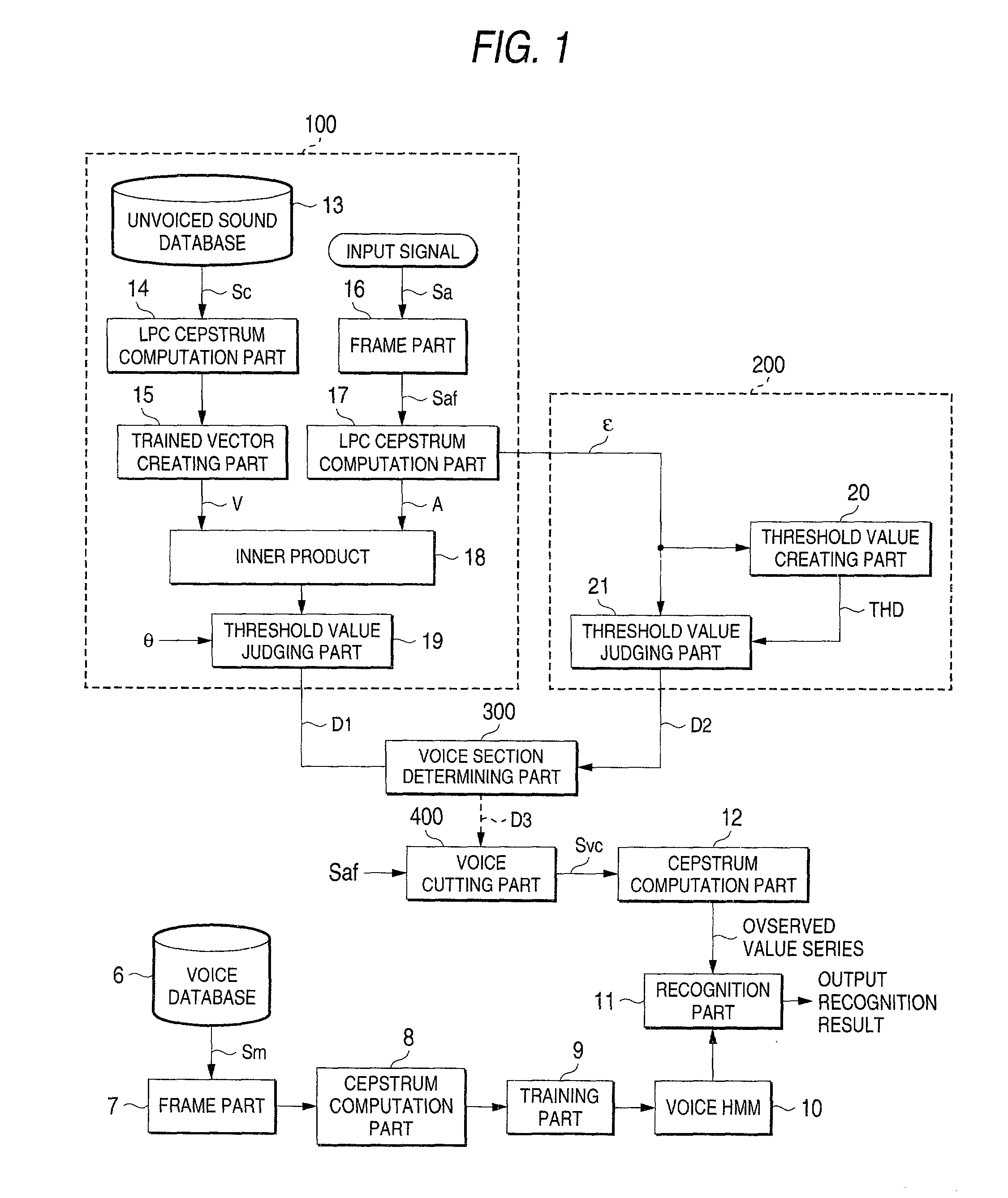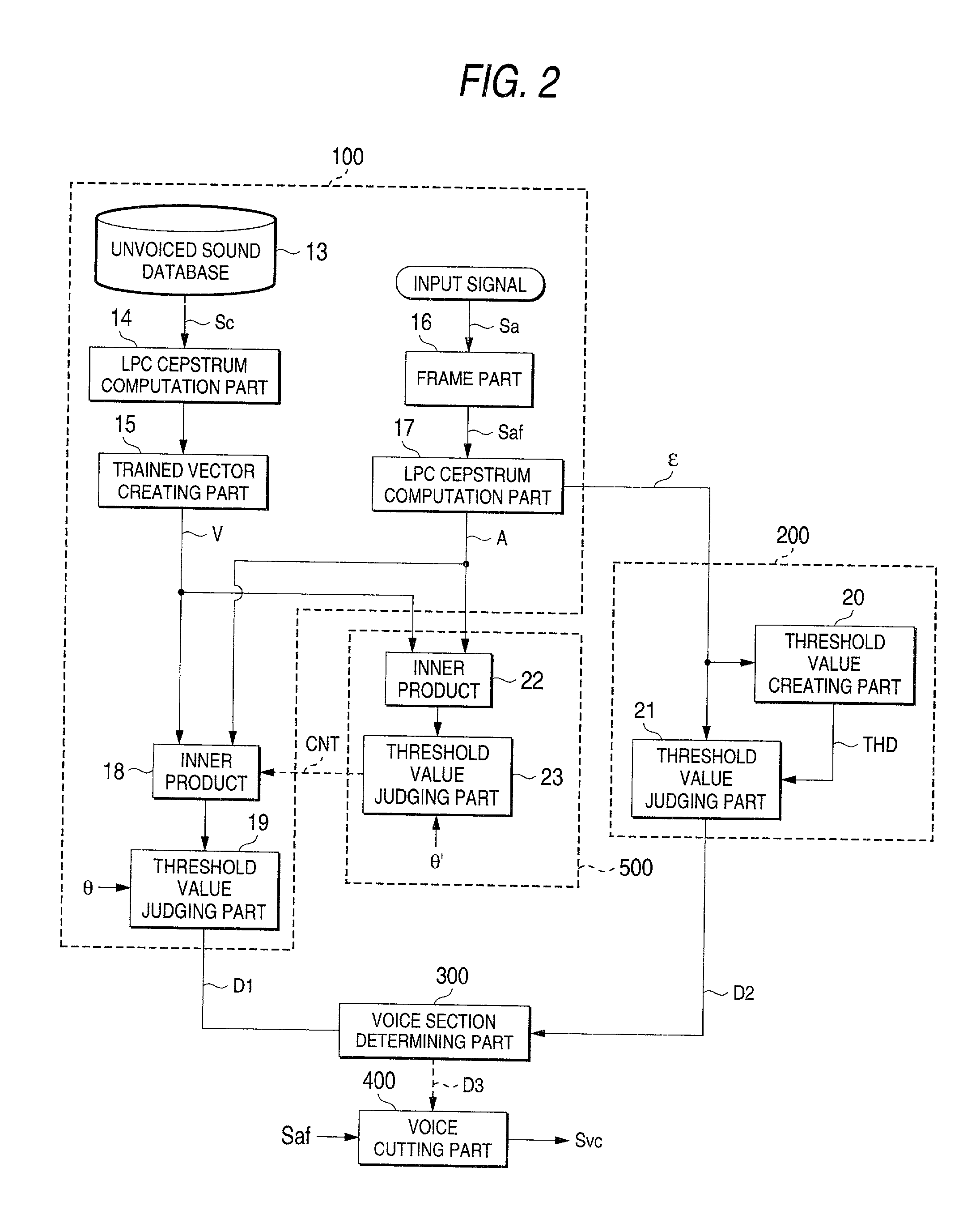Voice recognition system
a voice recognition and voice technology, applied in speech recognition, speech analysis, instruments, etc., can solve the problems of small predictive residual power difference between a noise and an original voice, low detection accuracy of detecting a voice section, and difficulty in detecting a part of an unvoiced sound whose power is small
- Summary
- Abstract
- Description
- Claims
- Application Information
AI Technical Summary
Benefits of technology
Problems solved by technology
Method used
Image
Examples
first embodiment
[0052] First Embodiment
[0053] This embodiment is typically directed to a voice recognition system which recognizes a voice by means of an HMM method and comprises a part which cuts out a voice for the purpose of voice recognition.
[0054] In FIG. 1, the voice recognition system of the first preferred embodiment comprises acoustic models (voice HMMs) 10 which are created in units of words or sub-words using a Hidden Markov Model, a recognition part 11, and a cepstrum computation part 12. The recognition part 11 checks an observed value series, which is a cepstrum time series of an input voice which is created by the cepstrum computation part 12, against the voice HMMs 10, selects the voice HMM which bears the largest likelihood and outputs this as a recognition result.
[0055] In other words, a frame part 7 partitions voice data Sm which have been collected and stored in a voice database 6 into predetermined frames, and a cepstrum computation part 8 sequentially computes cepstrum of the ...
second embodiment
[0076] Second Embodiment
[0077] Next, a voice recognition system according to a second preferred embodiment will be described with reference to FIG. 2. In FIG. 2, the portions which are the same as or correspond to those in FIG. 1 are denoted at the same reference symbols.
[0078] A difference of FIG. 2 from the first preferred embodiment is that the voice recognition system according to the second preferred embodiment comprises an incorrect judgment controlling part 500 which comprises an inner product computation part 22 and a third threshold value judging part 23.
[0079] During a non-voice period until the speaker actually starts speaking since a speaker turns on a speak start switch (not shown) of the voice recognition system, the inner product computation part 22 calculates an inner product of the feature vector A which is calculated by the LPC cepstrum computation part 17 and the trained vector V of an unvoiced sound calculated in advance by the trained vector creating part 15. Th...
third embodiment
[0088] Third Embodiment
[0089] Next, a voice recognition system according to a third preferred embodiment will be described with reference to FIG. 3. In FIG. 3, the portions which are the same as or correspond to those in FIG. 2 are denoted at the same reference symbols.
[0090] A difference between the embodiment shown in FIG. 3 and the second embodiment shown in FIG. 2 is that in the voice recognition system according to the second preferred embodiment, as shown in FIG. 2, the inner product V.sup.TA of the trained vector V and the feature vector A, which is calculated by the LPC cepstrum computation part 17 during a non-voice period before actual utterance of a voice, is calculated and the processing by the inner product computation part 18 is stopped when the calculated inner product satisfies .epsilon.'<V.sup.TA, whereby an incorrect judgment of a voice section is avoided.
[0091] In contrast, as shown in FIG. 3, the third preferred embodiment is directed to a structure in which an i...
PUM
 Login to View More
Login to View More Abstract
Description
Claims
Application Information
 Login to View More
Login to View More - R&D
- Intellectual Property
- Life Sciences
- Materials
- Tech Scout
- Unparalleled Data Quality
- Higher Quality Content
- 60% Fewer Hallucinations
Browse by: Latest US Patents, China's latest patents, Technical Efficacy Thesaurus, Application Domain, Technology Topic, Popular Technical Reports.
© 2025 PatSnap. All rights reserved.Legal|Privacy policy|Modern Slavery Act Transparency Statement|Sitemap|About US| Contact US: help@patsnap.com



